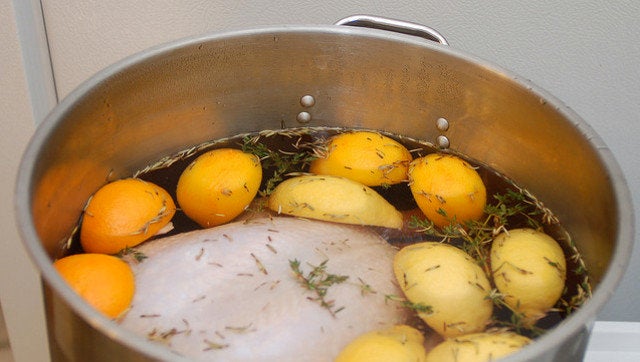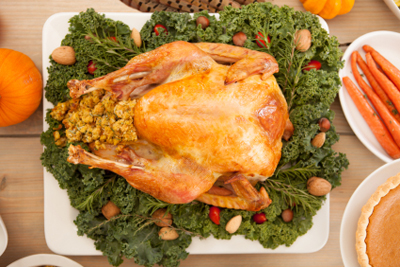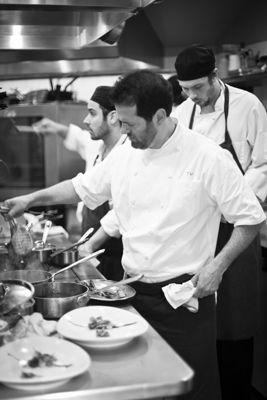

By Louisa Kasdon
Turkey conversation season is upon us again, with our annual quest for a crisp, moist, perfect bird. Some swear by brining the turkey (or any poultry) in a bucket with spices and salt to improve flavor and texture. I'm a skeptic with a standard home kitchen. Our family is big, and so are the birds we roast to feed them. Do I really need to give my 18-pound turkey an overnight beauty bath? Is the mess worth the work?
I asked Chef Tony Maws, chef owner of the award-winning bistro Craigie on Main in Cambridge, Mass. Maws, a recent James Beard Best Chef Northeast winner, is known around town as a perfectionist. One of the pioneers of the locavore movement and nose-to-tail cooking, in his early days Maws was known as a chef whose standards were so high that local suppliers wept during deliveries to his restaurant as he inspected and refused their local bounty. Maws has mellowed a bit. But he's still a stickler known for serving perfect poultry. He seemed like a good person to ask about brining.
It turns out that although he has a great brining recipe (see below), he doesn't think it's a make-or-break step for a turkey. He gets dozens of frantic calls from his regular diners around Thanksgiving, he says. "Foil, not foil? High temp, low temp? Turn the bird midway, or roast it standing up? Almost none of it matters since there is so much variability in cooking a turkey. But a lot of people do ask me about brining."

Maws thinks brining is just one of the things you can do to turn out a terrific bird. Brining, he explains, is an attempt to put two things into equilibrium by osmosis: the natural salinity of the fresh bird and the higher salt of the brine. The idea is that you can equalize the saline content in the bird and keep it moist and juicy and add a flavor kick to a pretty, plain protein without adding more salt. "The hard thing is that you can't taste what is happening to the raw bird as it as brining, so you sort have to take it on faith."
Related: What's the secret to flavorful, no-stress gravy?
Maws says it never hurts a turkey -- or any poultry -- to be brined for six to eight hours or overnight, and it helps even more if you can rest the bird for another day out of the brine before serving, but he doubts it is practical for most households to add two more steps to a busy holiday ritual. "Brining is an effective tool, but sort of a hassle for a standard home kitchen. Very few people have the space to refrigerate a big turkey in a bucket of water overnight. Not everyone has a restaurant-scale walk-in."
"Look," he says, rubbing his beard stubble with a faintly piratical smile, "I know it's sacrilegious, but the idea of cooking a whole turkey in a standard stove and having it come out perfectly done is ridiculous. Breasts and legs need different amounts of time for optimal doneness. Even if you set your oven to 350 degrees Fahrenheit the temperature even in a fancy home oven fluctuates between 325 degrees and 425 degrees Fahrenheit. Between the corners of the oven and the contours of the bird, it's always a different temperature at any given moment."
Related: What's the perfect way to get the best pieces of turkey?
Maws says when the breast is done, the legs still need some time. If you use the internal temperature of the legs as a guide, you dry out the breast. He's given up on roasting a whole turkey and prefers to buy a good bird, break it down and roast it in pieces, removing the breast from the oven and letting the legs spend more time in the heat. According to Maws, the ideal interior temperature for a turkey breast is 143 F (62 C) and for the legs it is 150 F (66 C). As you can tell, he's a pretty precise guy.
Related: Easy, quick, memorable appetizer? This one won't disappoint
His suggestion for diehards married to the ooh-aah public presentation of a pristine golden bird: "Bring it out, show it around, take it back to the kitchen and put the legs back in the oven for 10 more minutes. That's what the French do."
Related: Don't want pumpkin? Try persimmons
Maws' inflexible turkey rule: "Buy a good turkey. I'm not trying to be hippy-dippy, but all the things you read about free-range and natural birds are true. Turkeys are large, lean birds, much leaner than a plump, fat chicken, so you want to pay special attention to how the turkeys are raised and fed. The better and healthier the bird, the better the texture and flavor."
Tony Maws' Poultry Brine
5 liters of water, or less if you are using a brining bag for a 12- to 14-pound turkey
60 grams kosher salt
11 grams Kombu
1 teaspoon dried thyme
2 teaspoons coriander seeds
2 teaspoons fennel seeds
2 allspice berries
2 juniper berries
1 teaspoon chili flakes
2 cloves
Directions
Mix all the ingredients together in a bucket or container large enough to accommodate the turkey. Add the bird once thoroughly mixed.
Zester Daily contributor Louisa Kasdon is a Boston-based food writer, former restaurant owner and founder of letstalkaboutfood.com.
Also on Zester Daily:
Aid Sandy recovery by eating northeastern seafood
Photos, from top:
A Thanksgiving turkey. Credit: iStockPhoto
Chef Tony Maws. Credit: Michael Piazza